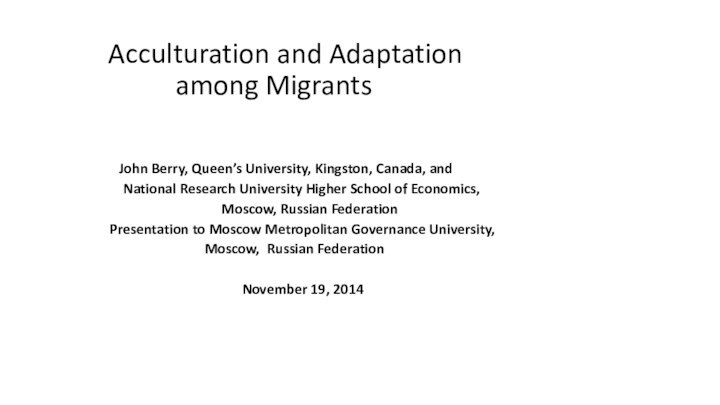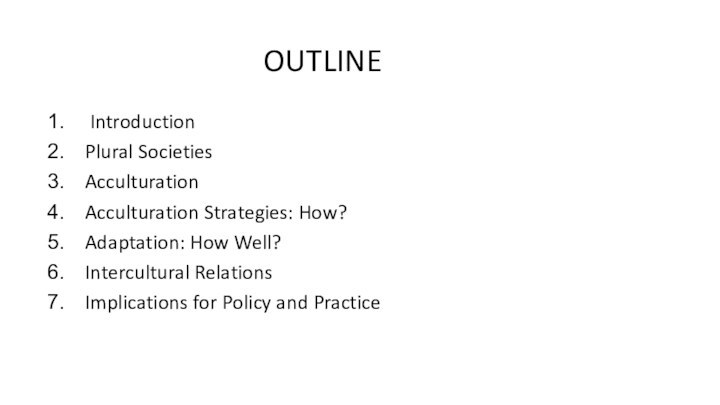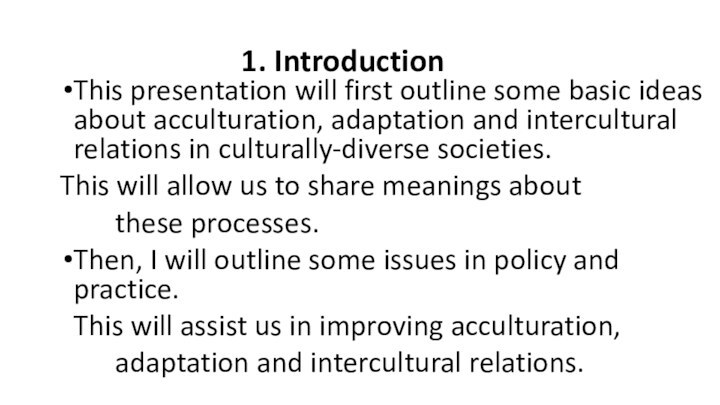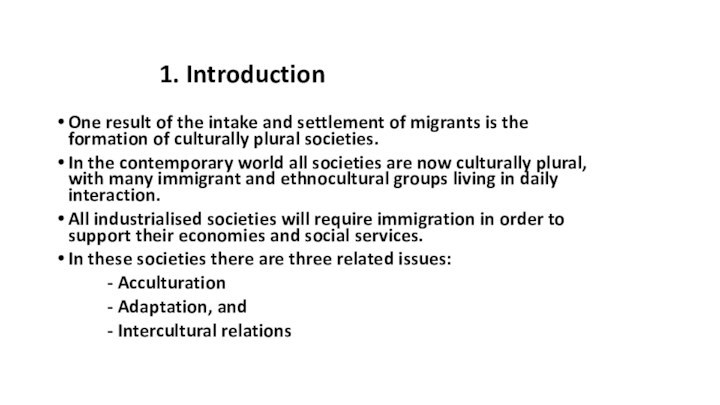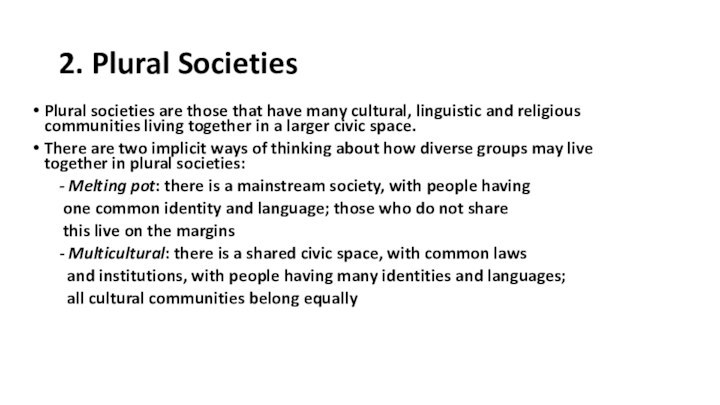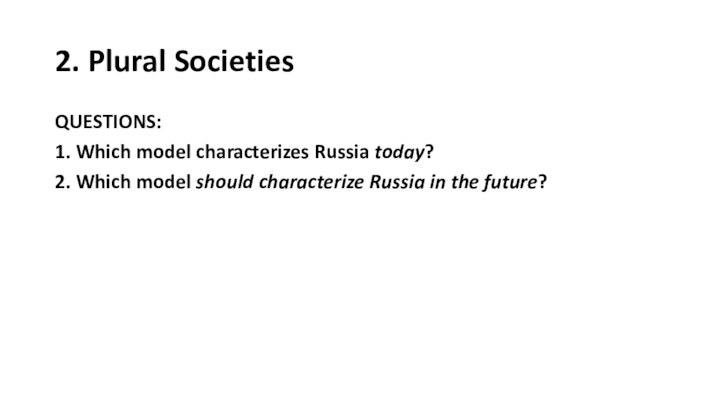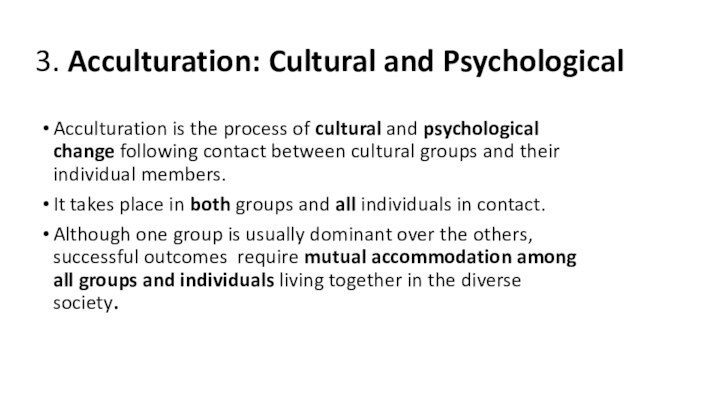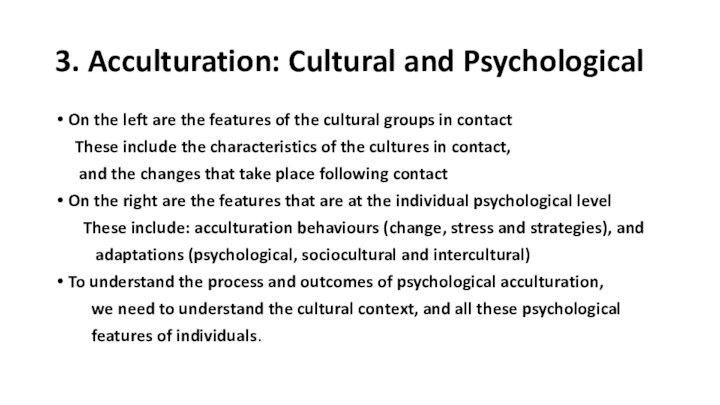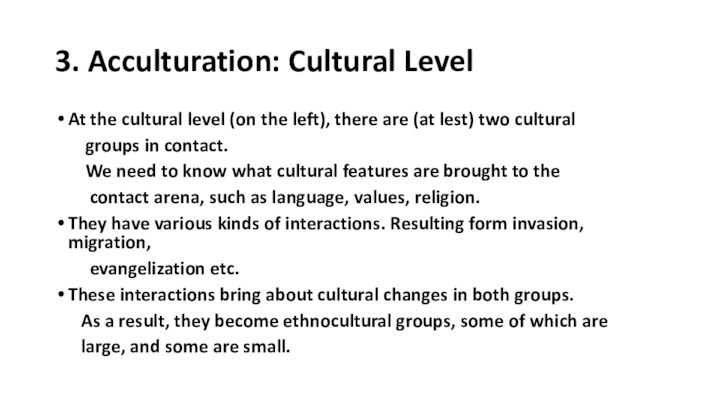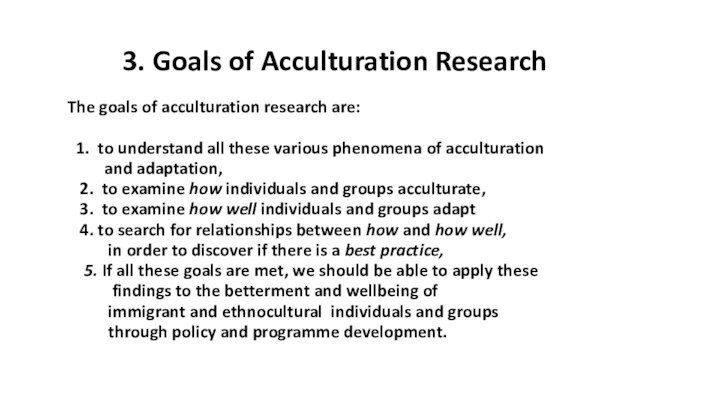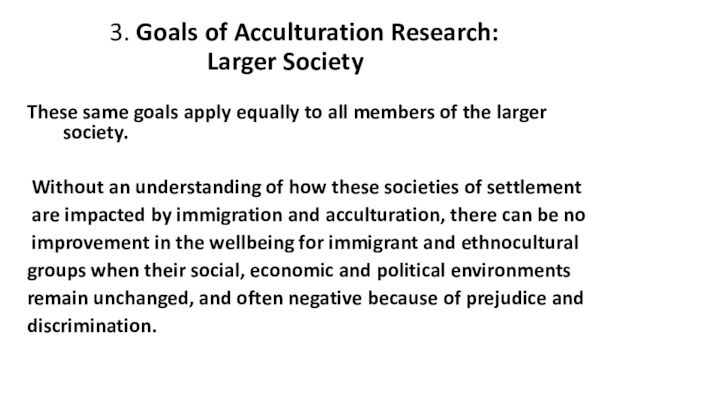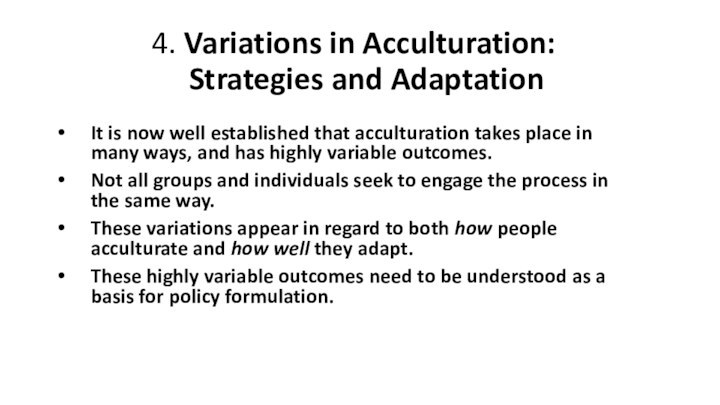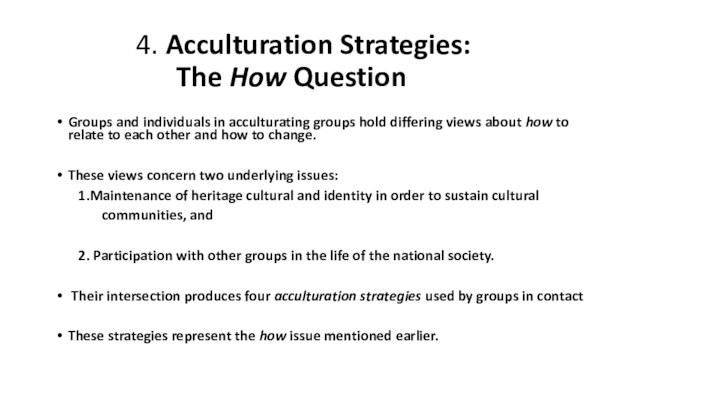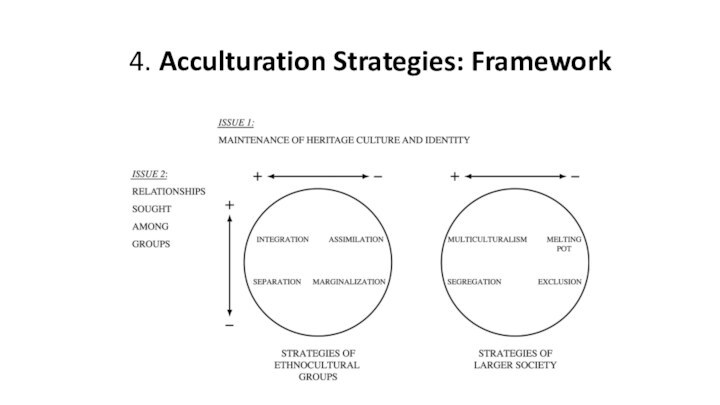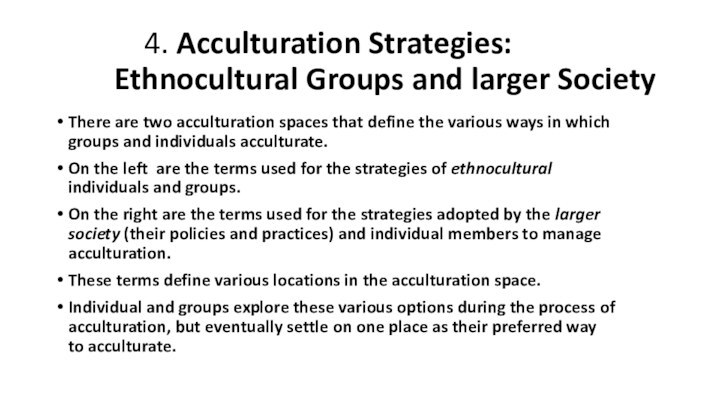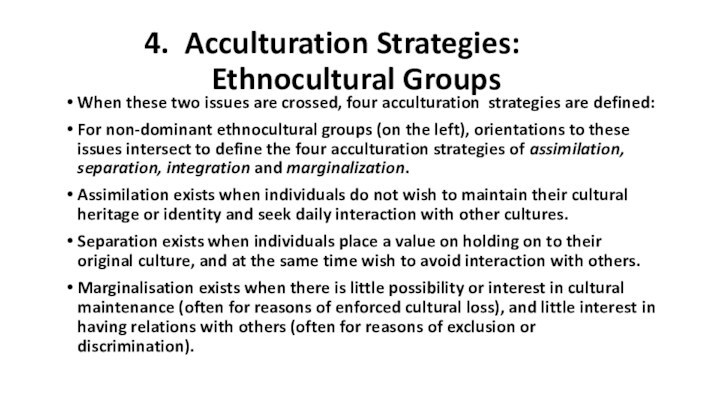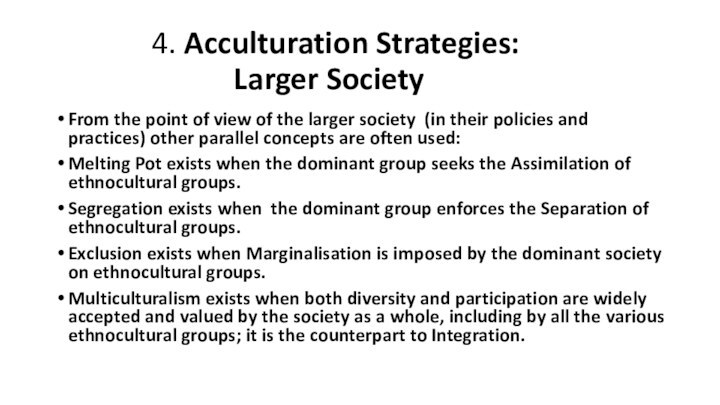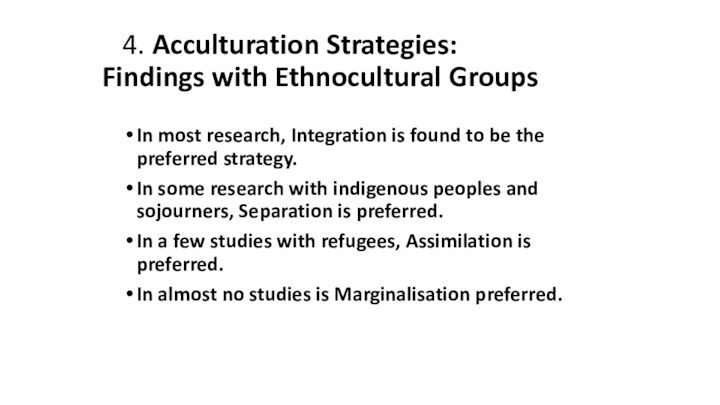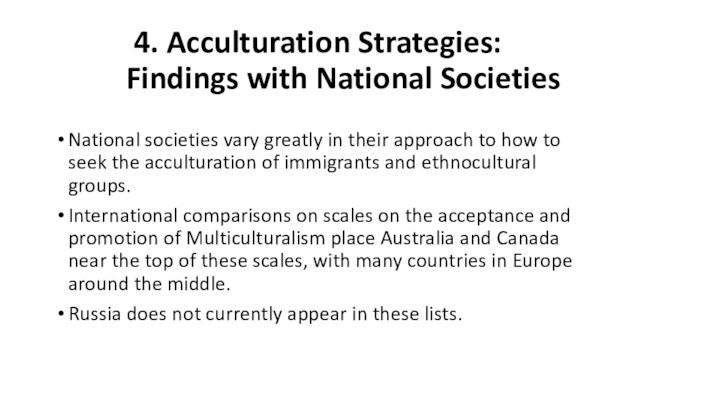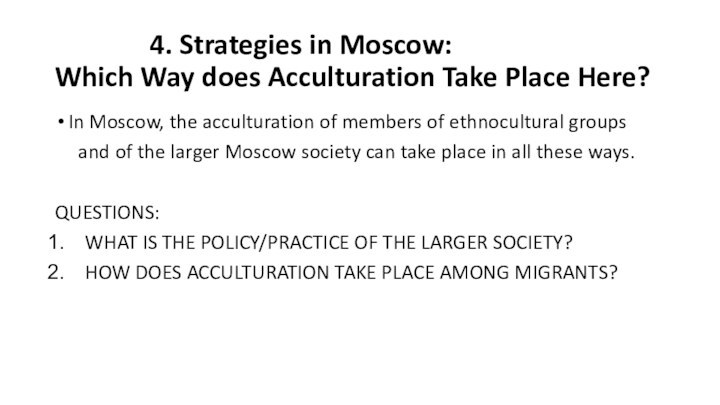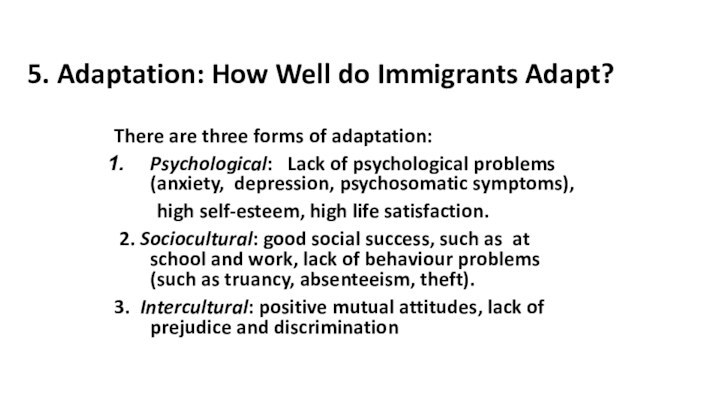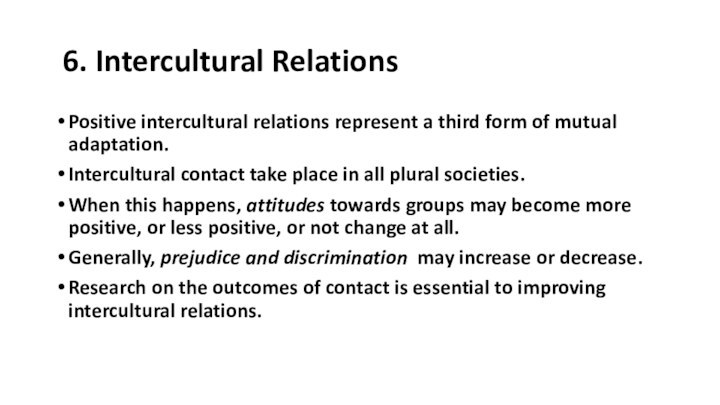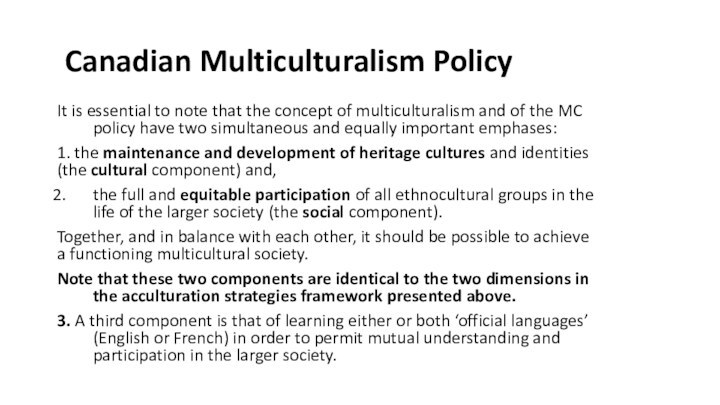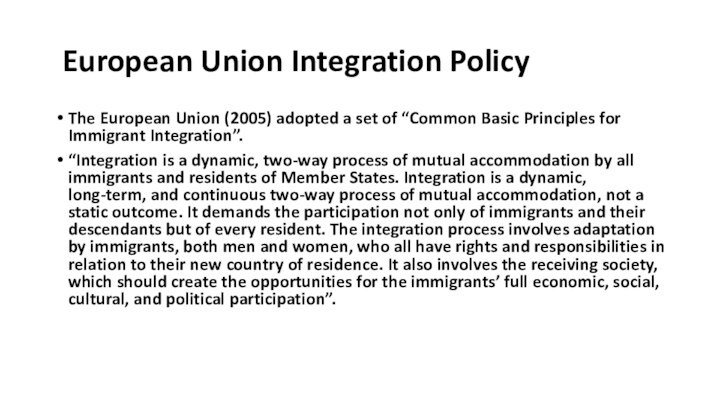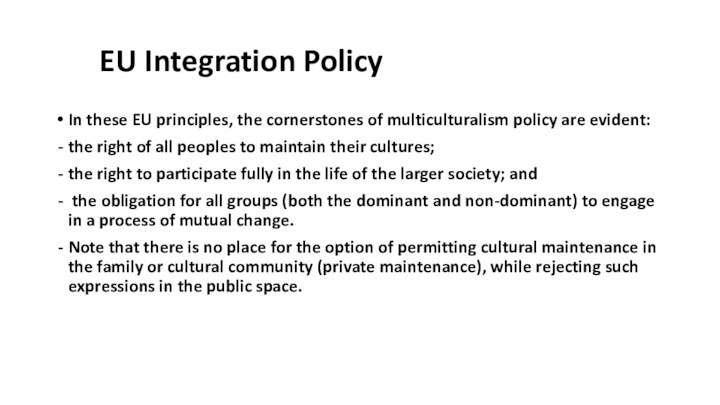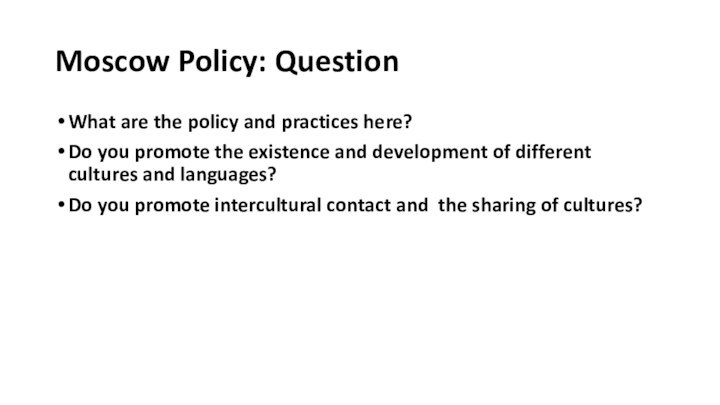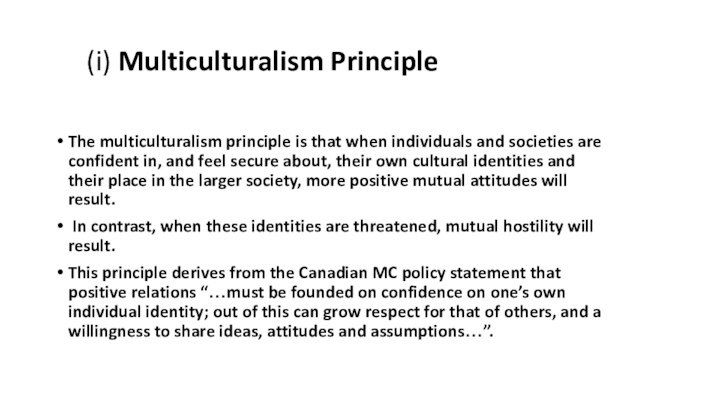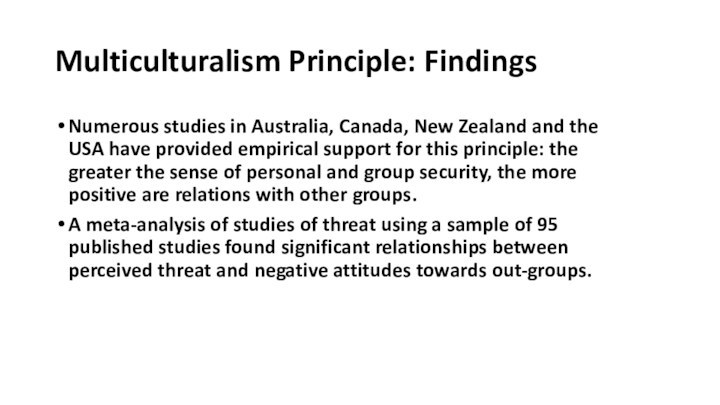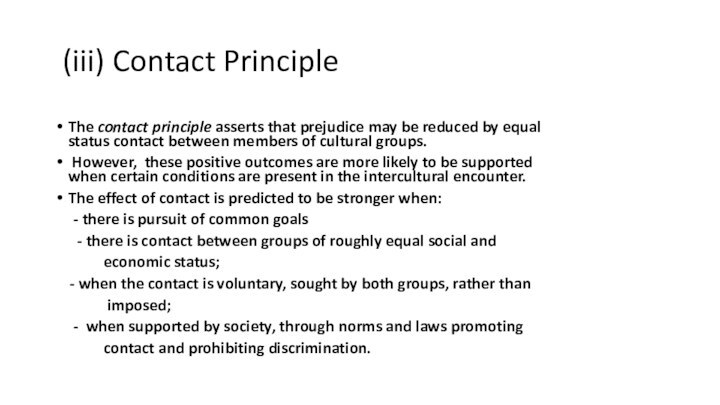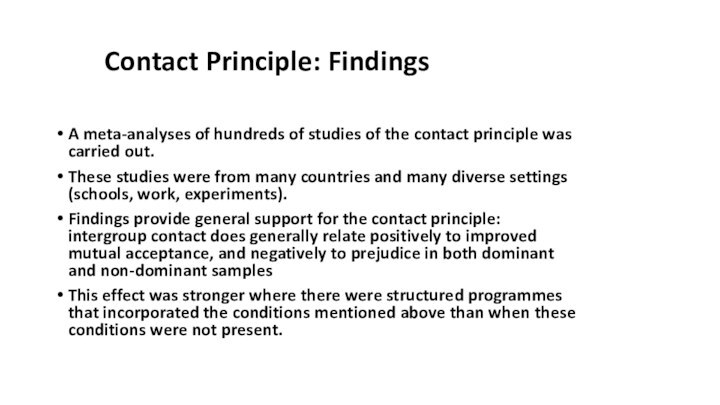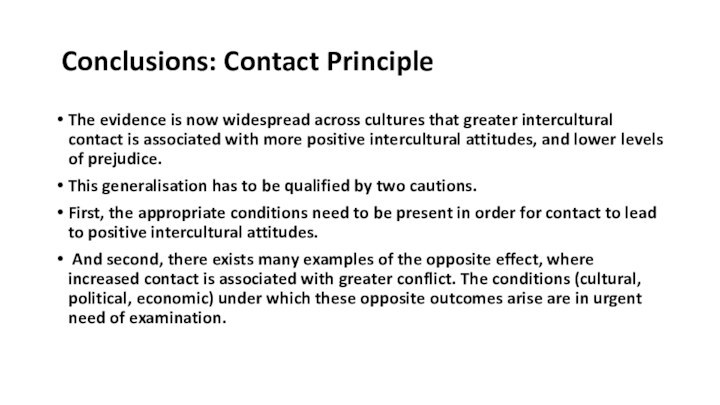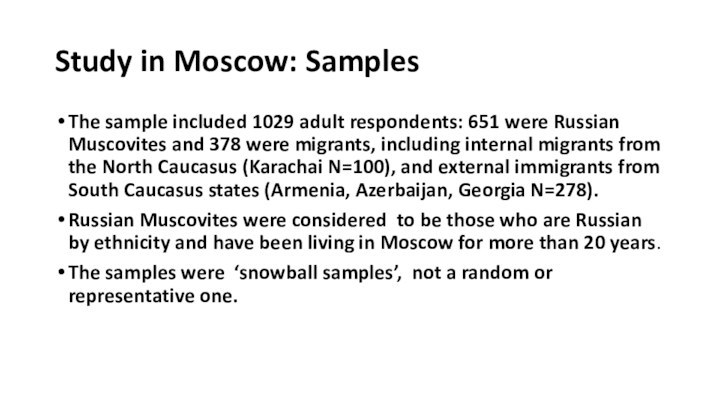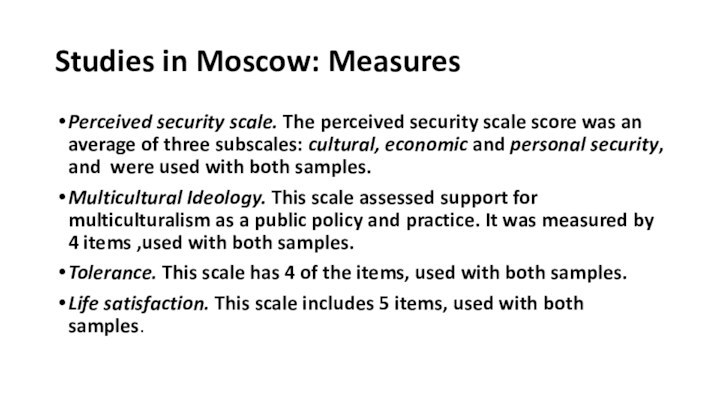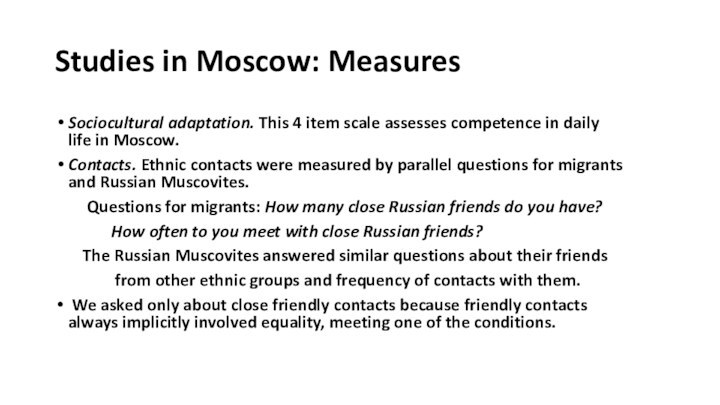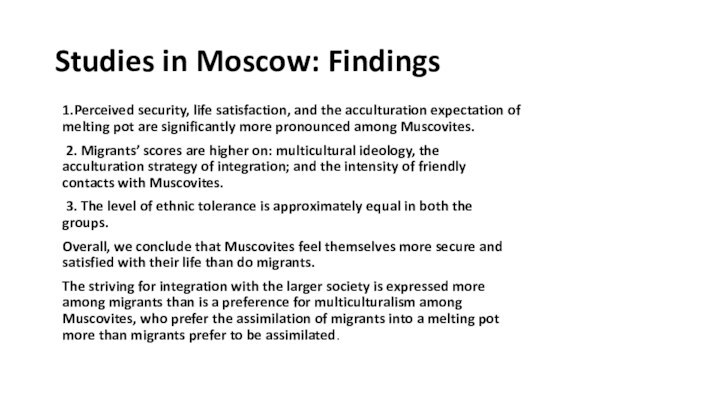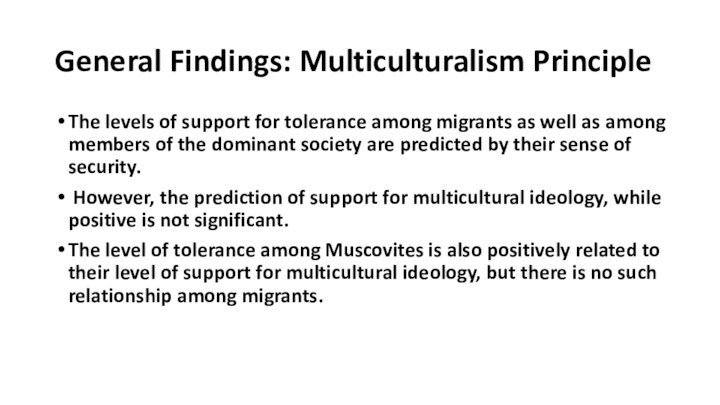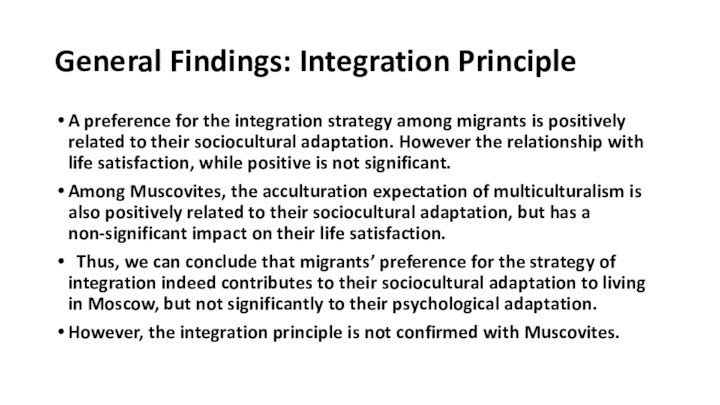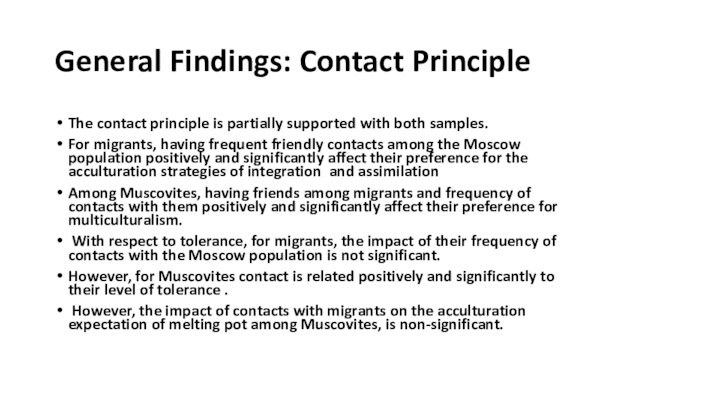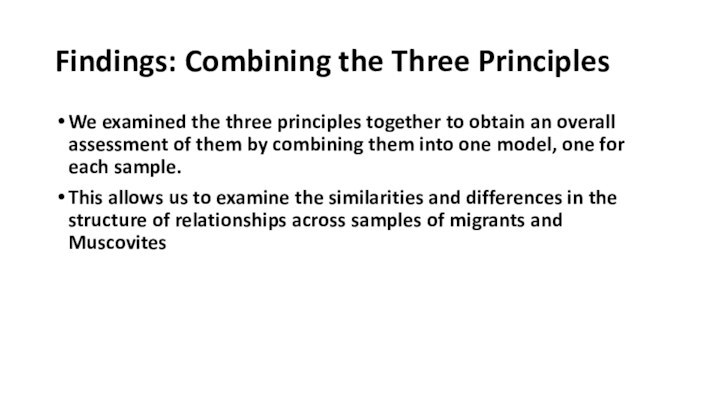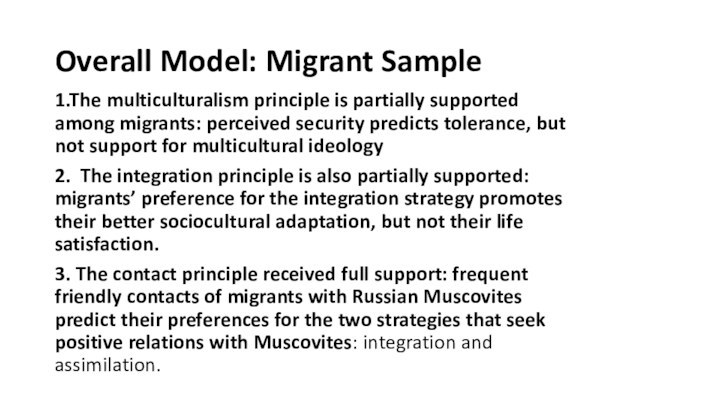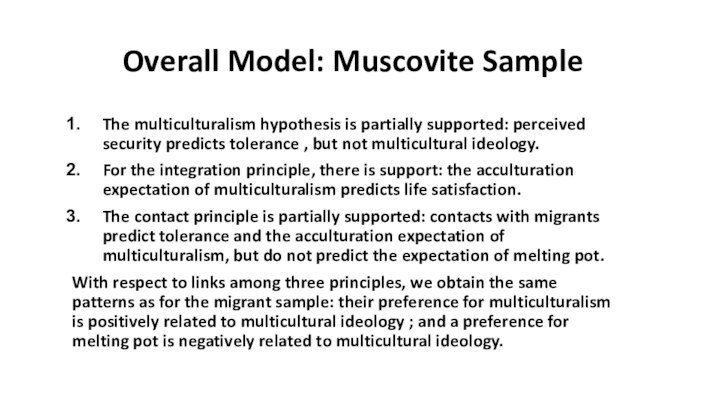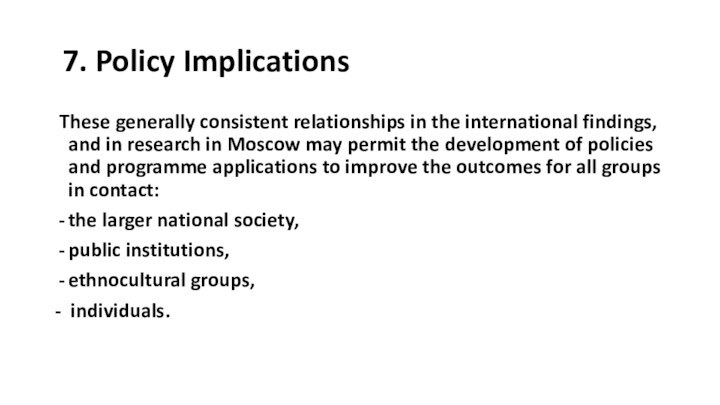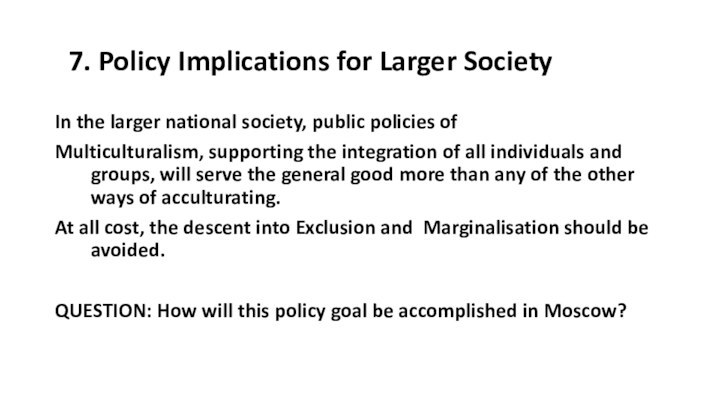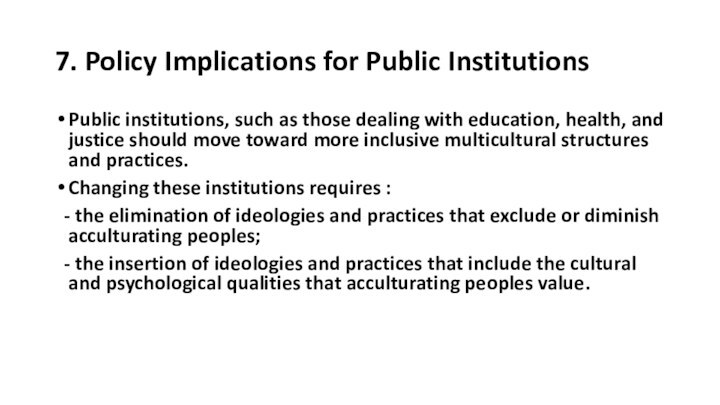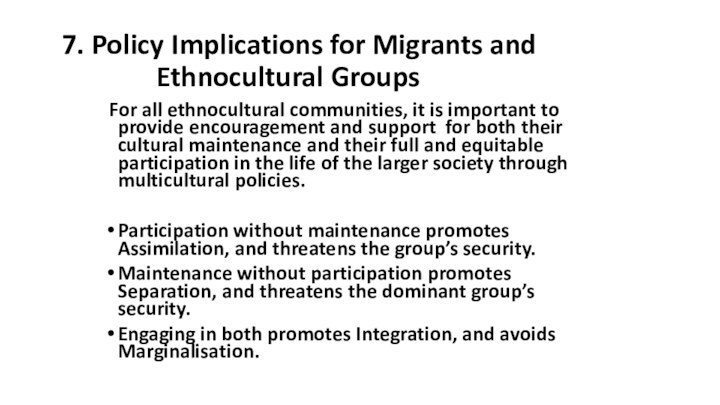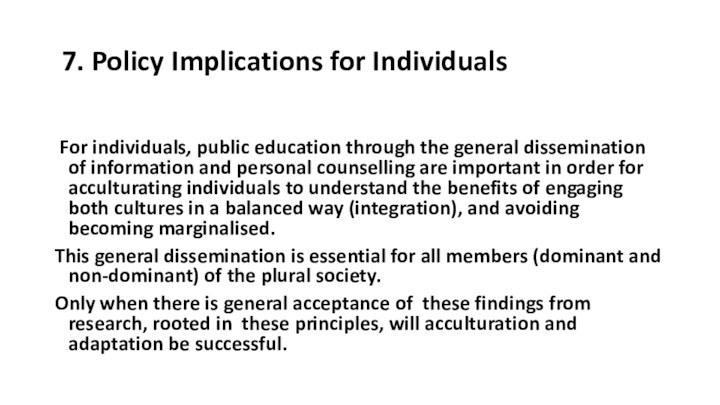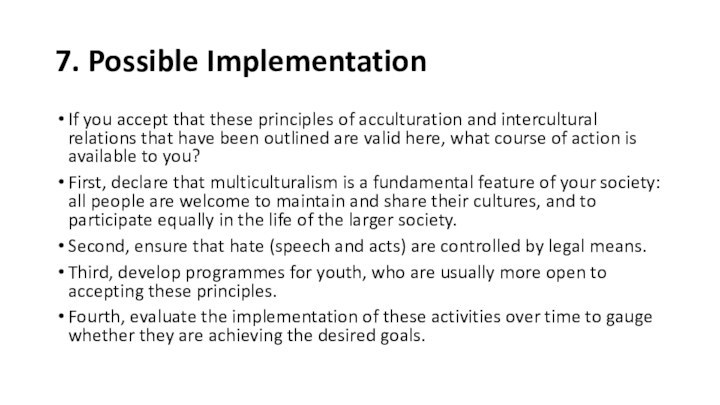OUTLINE
Introduction
Plural Societies
Acculturation
Acculturation
Strategies: How?
Adaptation: How Well?
Intercultural Relations
Implications for Policy and Practice
1. Introduction
This presentation will
first outline some basic ideas about acculturation, adaptation and intercultural relations in culturally-diverse societies.
This will allow us to share meanings about
these processes.
Then, I will outline some issues in policy and practice.
This will assist us in improving acculturation,
adaptation and intercultural relations.
Слайд 4
1. Introduction
One result of the intake and settlement
of migrants is the formation of culturally plural societies.
In the contemporary world all societies are now culturally plural, with many immigrant and ethnocultural groups living in daily interaction.
All industrialised societies will require immigration in order to support their economies and social services.
In these societies there are three related issues:
- Acculturation
- Adaptation, and
- Intercultural relations
Слайд 5
2. Plural Societies
Plural societies are those that have
many cultural, linguistic and religious communities living together in
a larger civic space.
There are two implicit ways of thinking about how diverse groups may live together in plural societies:
- Melting pot: there is a mainstream society, with people having
one common identity and language; those who do not share
this live on the margins
- Multicultural: there is a shared civic space, with common laws
and institutions, with people having many identities and languages;
all cultural communities belong equally
Слайд 6
2. Two Implicit Models of Plural Societies
Слайд 7
2. Plural Societies
QUESTIONS:
1. Which model characterizes Russia today?
2.
Which model should characterize Russia in the future?
Слайд 8
3. Acculturation: Cultural and Psychological
Acculturation is
the process of cultural and psychological change following contact
between cultural groups and their individual members.
It takes place in both groups and all individuals in contact.
Although one group is usually dominant over the others, successful outcomes require mutual accommodation among all groups and individuals living together in the diverse society.
Слайд 9
3. Acculturation: General Framework
Слайд 10
3. Acculturation: Cultural and Psychological
On the left are
the features of the cultural groups in contact
These include the characteristics of the cultures in contact,
and the changes that take place following contact
On the right are the features that are at the individual psychological level
These include: acculturation behaviours (change, stress and strategies), and
adaptations (psychological, sociocultural and intercultural)
To understand the process and outcomes of psychological acculturation,
we need to understand the cultural context, and all these psychological
features of individuals.
Слайд 11
3. Acculturation: Cultural Level
At the cultural level (on
the left), there are (at lest) two cultural
groups in contact.
We need to know what cultural features are brought to the
contact arena, such as language, values, religion.
They have various kinds of interactions. Resulting form invasion, migration,
evangelization etc.
These interactions bring about cultural changes in both groups.
As a result, they become ethnocultural groups, some of which are
large, and some are small.
Слайд 12
3. Acculturation: Psychological Level
At the psychological level (right
side) there are two kinds of phenomena
Psychological acculturation includes:
-Behavioural changes, such as food, dress, language, social links
-Acculturative Stress, such as anxiety, depression, low self esteem
- Acculturation Strategies: how do people want to interact?
*Adaptations include:
- Psychological, such as a clear identity, life satisfaction
- Sociocultural, such as doing well at school, at work, in the community
- Intercultural, such as positive intergroup attitudes, low levels of
prejudice and discrimination
Acculturation Research
The goals of acculturation research are:
1. to
understand all these various phenomena of acculturation
and adaptation,
2. to examine how individuals and groups acculturate,
3. to examine how well individuals and groups adapt
4. to search for relationships between how and how well,
in order to discover if there is a best practice,
5. If all these goals are met, we should be able to apply these
findings to the betterment and wellbeing of
immigrant and ethnocultural individuals and groups
through policy and programme development.
Acculturation Research:
Larger Society
These same goals apply equally to all members of the larger society.
Without an understanding of how these societies of settlement
are impacted by immigration and acculturation, there can be no
improvement in the wellbeing for immigrant and ethnocultural
groups when their social, economic and political environments
remain unchanged, and often negative because of prejudice and
discrimination.
Variations in Acculturation:
Strategies and Adaptation
It is now well established that acculturation takes place in many ways, and has highly variable outcomes.
Not all groups and individuals seek to engage the process in the same way.
These variations appear in regard to both how people acculturate and how well they adapt.
These highly variable outcomes need to be understood as a basis for policy formulation.
Слайд 16
4. Acculturation
Strategies:
The How Question
Groups and individuals in acculturating groups hold differing views about how to relate to each other and how to change.
These views concern two underlying issues:
1.Maintenance of heritage cultural and identity in order to sustain cultural
communities, and
2. Participation with other groups in the life of the national society.
Their intersection produces four acculturation strategies used by groups in contact
These strategies represent the how issue mentioned earlier.
Слайд 17
4. Acculturation
Strategies: Framework
Слайд 18
4. Acculturation
Strategies:
Ethnocultural Groups and larger Society
There
are two acculturation spaces that define the various ways in which groups and individuals acculturate.
On the left are the terms used for the strategies of ethnocultural individuals and groups.
On the right are the terms used for the strategies adopted by the larger society (their policies and practices) and individual members to manage acculturation.
These terms define various locations in the acculturation space.
Individual and groups explore these various options during the process of acculturation, but eventually settle on one place as their preferred way to acculturate.
Слайд 19
4. Acculturation
Strategies:
Ethnocultural Groups
When these two issues are crossed, four acculturation strategies are defined:
For non-dominant ethnocultural groups (on the left), orientations to these issues intersect to define the four acculturation strategies of assimilation, separation, integration and marginalization.
Assimilation exists when individuals do not wish to maintain their cultural heritage or identity and seek daily interaction with other cultures.
Separation exists when individuals place a value on holding on to their original culture, and at the same time wish to avoid interaction with others.
Marginalisation exists when there is little possibility or interest in cultural maintenance (often for reasons of enforced cultural loss), and little interest in having relations with others (often for reasons of exclusion or discrimination).
Слайд 20
4. Acculturation
Strategies:
Ethnocultural Groups
Integration exists when there is an interest in both maintaining one’s original culture and identity, while being in daily interactions with other groups.
In this case, there is some degree of cultural integrity maintained; at the same time, as a member of an ethnocultural group, there is a desire to participate as an integral part of the larger society.
Note that integration has a very specific meaning within this framework: it is clearly different from assimilation (because with integration, there is substantial cultural maintenance); and it is not a generic term referring to just any kind of long term involvement of an immigrant group in the society of settlement.
Acculturation Strategies:
Larger Society
From the point of view of the larger society (in their policies and practices) other parallel concepts are often used:
Melting Pot exists when the dominant group seeks the Assimilation of ethnocultural groups.
Segregation exists when the dominant group enforces the Separation of ethnocultural groups.
Exclusion exists when Marginalisation is imposed by the dominant society on ethnocultural groups.
Multiculturalism exists when both diversity and participation are widely accepted and valued by the society as a whole, including by all the various ethnocultural groups; it is the counterpart to Integration.
Слайд 22
4. Acculturation Strategies:
Findings with Ethnocultural Groups
In most
research, Integration is found to be the preferred strategy.
In some research with indigenous peoples and sojourners, Separation is preferred.
In a few studies with refugees, Assimilation is preferred.
In almost no studies is Marginalisation preferred.
Слайд 23
4. Acculturation Strategies:
Findings with National Societies
National
societies vary greatly in their approach to how to
seek the acculturation of immigrants and ethnocultural groups.
International comparisons on scales on the acceptance and promotion of Multiculturalism place Australia and Canada near the top of these scales, with many countries in Europe around the middle.
Russia does not currently appear in these lists.
Strategies in Moscow:
Which Way does Acculturation Take Place Here?
In
Moscow, the acculturation of members of ethnocultural groups
and of the larger Moscow society can take place in all these ways.
QUESTIONS:
WHAT IS THE POLICY/PRACTICE OF THE LARGER SOCIETY?
HOW DOES ACCULTURATION TAKE PLACE AMONG MIGRANTS?
Слайд 25
5. Adaptation: How Well do Immigrants Adapt?
There
are three forms of adaptation:
Psychological: Lack of psychological
problems (anxiety, depression, psychosomatic symptoms),
high self-esteem, high life satisfaction.
2. Sociocultural: good social success, such as at school and work, lack of behaviour problems (such as truancy, absenteeism, theft).
3. Intercultural: positive mutual attitudes, lack of prejudice and discrimination
Слайд 26
5. Adaptation: How Well do Immigrants Adapt?
Research
shows that immigrants vary in their adaptation, depending on
a number of factors. The main ones are:
Length of residence: it takes time to find a successful place in the larger society.
Social support: social interactions and services are important for achieving positive adaptation
Acculturation strategies: There are important relationships between acculturation strategies and adaptation.
Discrimination (both personal and systemic): such negative acts reduces the opportunity to achieve the first two forms of adaptation.
Слайд 27
5. How Well do Immigrants Adapt in
Relations
to Acculturation
Strategies?
In response to the question about relationship between acculturation strategies and adaptation, the answer is now very clear:
In both the larger society and members of migrant groups:
- Integration/Multiculturalism promotes better adaptation,
- Marginalization/Exclusion promotes the worst adaptation.
- Assimilation/Melting Pot and Separation/Segregation strategies
usually have intermediate outcomes.
To achieve positive adaptation, the best strategy is to promote this double engagement by all members of the plural society
Слайд 28
6. Intercultural Relations
Positive intercultural relations represent a
third form of mutual adaptation.
Intercultural contact take place in
all plural societies.
When this happens, attitudes towards groups may become more positive, or less positive, or not change at all.
Generally, prejudice and discrimination may increase or decrease.
Research on the outcomes of contact is essential to improving intercultural relations.
Слайд 29
6. Multiculturalism Policy
The first national policy of
Multiculturalism was announced by the Canadian Federal government in
1971.
The goal was “to break down discriminatory attitudes and cultural jealousies”, in order to improve intercultural relations.
This goal was to be achieved by two main programmes:
- supporting ethnocultural communities in their wish to maintain their heritage cultures and identites, and
- by promoting intercultural contact and participation in the larger society.
Слайд 30
Canadian Multiculturalism Policy
The clear
and fundamental goal of the policy is to enhance
mutual acceptance among all cultural groups. This goal is to be approached through two main programme components.
The cultural component of the policy was to be achieved by providing support and encouragement for cultural maintenance and development among all cultural groups.
The social (or intercultural) component sought the sharing of cultural expressions by providing opportunities for intergroup contact, and the removal barriers to full and equitable participation in the daily life of the larger society.
The language component acknowledged the importance of learning a common language(s) in order to permit intercultural participation among all groups.
Canadian Multiculturalism Policy
Слайд 32
Canadian Multiculturalism Policy
It is essential to note
that the concept of multiculturalism and of the MC
policy have two simultaneous and equally important emphases:
1. the maintenance and development of heritage cultures and identities (the cultural component) and,
the full and equitable participation of all ethnocultural groups in the life of the larger society (the social component).
Together, and in balance with each other, it should be possible to achieve a functioning multicultural society.
Note that these two components are identical to the two dimensions in the acculturation strategies framework presented above.
3. A third component is that of learning either or both ‘official languages’ (English or French) in order to permit mutual understanding and participation in the larger society.
Слайд 33
European Union Integration Policy
The European Union (2005)
adopted a set of “Common Basic Principles for Immigrant
Integration”.
“Integration is a dynamic, two-way process of mutual accommodation by all immigrants and residents of Member States. Integration is a dynamic, long-term, and continuous two-way process of mutual accommodation, not a static outcome. It demands the participation not only of immigrants and their descendants but of every resident. The integration process involves adaptation by immigrants, both men and women, who all have rights and responsibilities in relation to their new country of residence. It also involves the receiving society, which should create the opportunities for the immigrants’ full economic, social, cultural, and political participation”.
Слайд 34
EU Integration Policy
In these EU
principles, the cornerstones of multiculturalism policy are evident:
the right
of all peoples to maintain their cultures;
the right to participate fully in the life of the larger society; and
the obligation for all groups (both the dominant and non-dominant) to engage in a process of mutual change.
Note that there is no place for the option of permitting cultural maintenance in the family or cultural community (private maintenance), while rejecting such expressions in the public space.
Слайд 35
Moscow Policy: Question
What are the policy and practices
here?
Do you promote the existence and development of different
cultures and languages?
Do you promote intercultural contact and the sharing of cultures?
Слайд 36
Three Principles of Intercultural Relations
Multiculturalism policy has
given rise to three principles that have been examined
by researchers in a number of societies.
These are the:
1. Multiculturalism principle
2. Integration principle
3. Contact principle
Слайд 37
(i) Multiculturalism Principle
The multiculturalism principle is that
when individuals and societies are confident in, and feel
secure about, their own cultural identities and their place in the larger society, more positive mutual attitudes will result.
In contrast, when these identities are threatened, mutual hostility will result.
This principle derives from the Canadian MC policy statement that positive relations “…must be founded on confidence on one’s own individual identity; out of this can grow respect for that of others, and a willingness to share ideas, attitudes and assumptions…”.
Слайд 38
Multiculturalism Principle: Findings
Numerous studies in Australia, Canada, New
Zealand and the USA have provided empirical support for
this principle: the greater the sense of personal and group security, the more positive are relations with other groups.
A meta-analysis of studies of threat using a sample of 95 published studies found significant relationships between perceived threat and negative attitudes towards out-groups.
Слайд 39
Multiculturalism Principle: Conclusions.
We conclude that the multiculturalism principle
has largely been supported.
Feelings of security and threat
appear to be part of the psychological underpinnings of the acceptance of those who are culturally different.
Whether phrased in positive terms (security is a prerequisite for tolerance of others and the acceptance of diversity), or in negative terms (threats to, or anxiety about, one’s cultural identity and cultural rights underpins prejudice), there is little doubt that there are intimate links between being accepted by others and accepting others.
Слайд 40
(ii) Integration Principle
The integration principle is that when
individuals are ‘doubly engaged’ (in both their heritage cultures
and in the larger society) they will have higher levels of psychological, sociocultural and intercultural adaptation.
A meta-analysis has shown that this relationship is indeed in evidence:
In over 80 studies (with over 8000 participants) integration
was positively associated with various forms of adaptation.
From these studies, we may conclude that the integration principle is generally supported.
Слайд 41
(iii) Contact Principle
The contact principle asserts that
prejudice may be reduced by equal status contact between
members of cultural groups.
However, these positive outcomes are more likely to be supported when certain conditions are present in the intercultural encounter.
The effect of contact is predicted to be stronger when:
- there is pursuit of common goals
- there is contact between groups of roughly equal social and
economic status;
- when the contact is voluntary, sought by both groups, rather than
imposed;
- when supported by society, through norms and laws promoting
contact and prohibiting discrimination.
Слайд 42
Contact Principle: Findings
A meta-analyses of hundreds of studies
of the contact principle was carried out.
These studies were
from many countries and many diverse settings (schools, work, experiments).
Findings provide general support for the contact principle: intergroup contact does generally relate positively to improved mutual acceptance, and negatively to prejudice in both dominant and non-dominant samples
This effect was stronger where there were structured programmes that incorporated the conditions mentioned above than when these conditions were not present.
Слайд 43
Conclusions: Contact Principle
The evidence is now widespread
across cultures that greater intercultural contact is associated with
more positive intercultural attitudes, and lower levels of prejudice.
This generalisation has to be qualified by two cautions.
First, the appropriate conditions need to be present in order for contact to lead to positive intercultural attitudes.
And second, there exists many examples of the opposite effect, where increased contact is associated with greater conflict. The conditions (cultural, political, economic) under which these opposite outcomes arise are in urgent need of examination.
Слайд 44
Studies in Moscow
There have been numerous studies of
acculturation, adaptation and intercultural relations in Moscow, with samples
of migrants and Muscovites.
Many of these were guided by the concepts and principles that have been presented here.
Some of these studies were carried out in the Department of Sociocultural Psychology, Higher School of Economics, National Research University, under the leadership of Prof. N. Lebedeva and Dr. A. Tatarko.
Following a is a brief summary of one of these studies.
Слайд 45
Study in Moscow: Samples
The sample included 1029 adult
respondents: 651 were Russian Muscovites and 378 were migrants,
including internal migrants from the North Caucasus (Karachai N=100), and external immigrants from South Caucasus states (Armenia, Azerbaijan, Georgia N=278).
Russian Muscovites were considered to be those who are Russian by ethnicity and have been living in Moscow for more than 20 years.
The samples were ‘snowball samples’, not a random or representative one.
Слайд 46
Studies in Moscow: Measures
Perceived security scale. The perceived
security scale score was an average of three subscales:
cultural, economic and personal security, and were used with both samples.
Multicultural Ideology. This scale assessed support for multiculturalism as a public policy and practice. It was measured by 4 items ,used with both samples.
Tolerance. This scale has 4 of the items, used with both samples.
Life satisfaction. This scale includes 5 items, used with both samples.
Слайд 47
Studies in Moscow: Measures
Acculturation strategies of migrants. We
used only the acculturation attitudes of integration and assimilation,
which are the two strategies representing a willingness to engage with the larger society.
The Integration scale includes 4 items; the Assimilation scale has 4 items. These scales were used with migrants only.
Acculturation expectations of Muscovites. Paralleling the acculturation strategies scale used with migrants, we used only the acculturation expectations of multiculturalism and melting pot. These are the two expectations representing a willingness to accept others into the larger society.
The Multiculturalism scale has 4 items; the Melting pot scale has 4 items. These scales were used with Russian Muscovites only.
Слайд 48
Studies in Moscow: Measures
Sociocultural adaptation. This 4 item
scale assesses competence in daily life in Moscow.
Contacts. Ethnic
contacts were measured by parallel questions for migrants and Russian Muscovites.
Questions for migrants: How many close Russian friends do you have?
How often to you meet with close Russian friends?
The Russian Muscovites answered similar questions about their friends
from other ethnic groups and frequency of contacts with them.
We asked only about close friendly contacts because friendly contacts always implicitly involved equality, meeting one of the conditions.
Слайд 49
Studies in Moscow: Findings
1.Perceived security, life satisfaction, and
the acculturation expectation of melting pot are significantly more
pronounced among Muscovites.
2. Migrants’ scores are higher on: multicultural ideology, the acculturation strategy of integration; and the intensity of friendly contacts with Muscovites.
3. The level of ethnic tolerance is approximately equal in both the groups.
Overall, we conclude that Muscovites feel themselves more secure and satisfied with their life than do migrants.
The striving for integration with the larger society is expressed more among migrants than is a preference for multiculturalism among Muscovites, who prefer the assimilation of migrants into a melting pot more than migrants prefer to be assimilated.
Слайд 50
General Findings: Multiculturalism Principle
The levels of support for
tolerance among migrants as well as among members of
the dominant society are predicted by their sense of security.
However, the prediction of support for multicultural ideology, while positive is not significant.
The level of tolerance among Muscovites is also positively related to their level of support for multicultural ideology, but there is no such relationship among migrants.
Слайд 51
General Findings: Integration Principle
A preference for the integration
strategy among migrants is positively related to their sociocultural
adaptation. However the relationship with life satisfaction, while positive is not significant.
Among Muscovites, the acculturation expectation of multiculturalism is also positively related to their sociocultural adaptation, but has a non-significant impact on their life satisfaction.
Thus, we can conclude that migrants’ preference for the strategy of integration indeed contributes to their sociocultural adaptation to living in Moscow, but not significantly to their psychological adaptation.
However, the integration principle is not confirmed with Muscovites.
Слайд 52
General Findings: Contact Principle
The contact principle is partially
supported with both samples.
For migrants, having frequent friendly
contacts among the Moscow population positively and significantly affect their preference for the acculturation strategies of integration and assimilation
Among Muscovites, having friends among migrants and frequency of contacts with them positively and significantly affect their preference for multiculturalism.
With respect to tolerance, for migrants, the impact of their frequency of contacts with the Moscow population is not significant.
However, for Muscovites contact is related positively and significantly to their level of tolerance .
However, the impact of contacts with migrants on the acculturation expectation of melting pot among Muscovites, is non-significant.
Слайд 53
Findings: Combining the Three Principles
We examined the three
principles together to obtain an overall assessment of them
by combining them into one model, one for each sample.
This allows us to examine the similarities and differences in the structure of relationships across samples of migrants and Muscovites
Слайд 54
Overall Model: Migrant Sample
1.The multiculturalism principle is partially
supported among migrants: perceived security predicts tolerance, but not
support for multicultural ideology
2. The integration principle is also partially supported: migrants’ preference for the integration strategy promotes their better sociocultural adaptation, but not their life satisfaction.
3. The contact principle received full support: frequent friendly contacts of migrants with Russian Muscovites predict their preferences for the two strategies that seek positive relations with Muscovites: integration and assimilation.
Слайд 55
Overall Model: Muscovite Sample
The multiculturalism hypothesis is partially
supported: perceived security predicts tolerance , but not multicultural
ideology.
For the integration principle, there is support: the acculturation expectation of multiculturalism predicts life satisfaction.
The contact principle is partially supported: contacts with migrants predict tolerance and the acculturation expectation of multiculturalism, but do not predict the expectation of melting pot.
With respect to links among three principles, we obtain the same patterns as for the migrant sample: their preference for multiculturalism is positively related to multicultural ideology ; and a preference for melting pot is negatively related to multicultural ideology.
Слайд 56
7. Policy Implications
These generally consistent relationships
in the international findings, and in research in Moscow
may permit the development of policies and programme applications to improve the outcomes for all groups in contact:
the larger national society,
public institutions,
ethnocultural groups,
- individuals.
Слайд 57
7. Policy Implications for Larger Society
In the
larger national society, public policies of
Multiculturalism, supporting the
integration of all individuals and groups, will serve the general good more than any of the other ways of acculturating.
At all cost, the descent into Exclusion and Marginalisation should be avoided.
QUESTION: How will this policy goal be accomplished in Moscow?
Слайд 58
7. Policy Implications for Public Institutions
Public institutions, such
as those dealing with education, health, and justice should
move toward more inclusive multicultural structures and practices.
Changing these institutions requires :
- the elimination of ideologies and practices that exclude or diminish acculturating peoples;
- the insertion of ideologies and practices that include the cultural and psychological qualities that acculturating peoples value.
Слайд 59
7. Policy Implications for Migrants and
Ethnocultural
Groups
For all ethnocultural communities, it is important to provide encouragement and support for both their cultural maintenance and their full and equitable participation in the life of the larger society through multicultural policies.
Participation without maintenance promotes Assimilation, and threatens the group’s security.
Maintenance without participation promotes Separation, and threatens the dominant group’s security.
Engaging in both promotes Integration, and avoids Marginalisation.
Слайд 60
7. Policy Implications for Individuals
For
individuals, public education through the general dissemination of information
and personal counselling are important in order for acculturating individuals to understand the benefits of engaging both cultures in a balanced way (integration), and avoiding becoming marginalised.
This general dissemination is essential for all members (dominant and non-dominant) of the plural society.
Only when there is general acceptance of these findings from research, rooted in these principles, will acculturation and adaptation be successful.
